When Was Mars Discovered? The History of Mars
Last Updated on
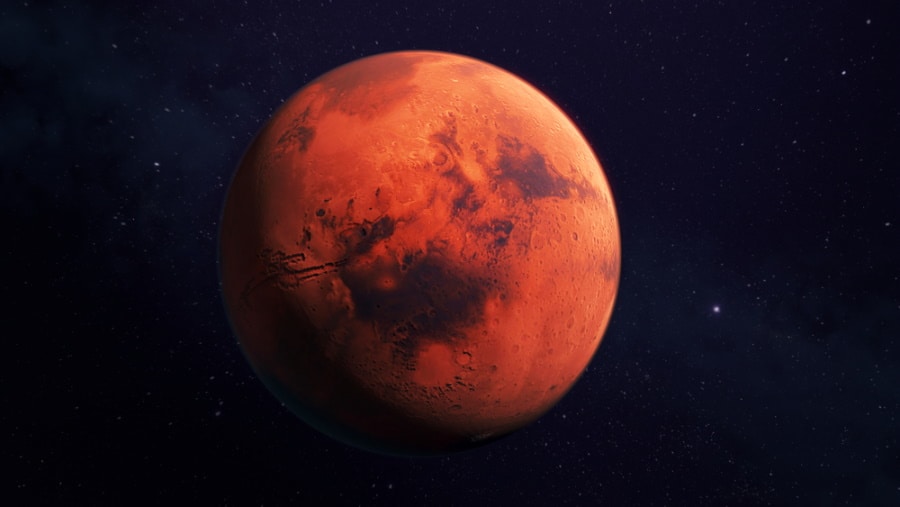
Mars, also known as the “Red Planet,” is a striking terrestrial world that is the fourth planet from the Sun. It is among the smallest planets in our solar system, second only to Mercury. As a nod to its blood-red color, both the ancient Greeks and Romans named the planet after their gods of war: Ares and Mars, respectively.
Several other languages use names that represent Mars’ breathtaking appearance, including the Arabic word Mirrīkh, meaning “fire,” the Chinese word Huǒxīng, meaning “fire star,” and the Sanskrit term Mangal, which refers to the Hindu god of anger.
Historically, Mars has been viewed since ancient times, especially since it is one of the brightest objects in Earth’s sky. Mars has been referenced in culture and the arts for centuries, mirroring humanity’s understanding and knowledge of the planet. However, it is difficult to say exactly when the Red Planet was discovered.
In ancient Mesopotamian texts, Mars is referred to as the “star of judgment of the fate of the dead.” The ancient Egyptians also recorded their observations of Mars, with astronomers becoming familiar with the planet’s retrograde motion by 1534 BC. During the Neo-Babylonian Empire, astronomers made systematic observations of the planets and analyzed Mars’ behavior in detail, concluding that it made 42 circuits of the zodiac every 79 years.
They also invented mathematical methods for correcting predicted planetary positions and recorded their findings regularly. In the fourth century BC, Aristotle observed Mars disappearing behind the Moon during an occultation, which is astronomical terminology for the period of time an object is hidden by a body passing between it and the observer. This led him to conclude that Mars was farther than the Moon.

Who First Discovered Mars?
Although no one is officially credited with discovering Mars, Galileo Galilei, an Italian astronomer, physicist, and engineer, was the first person to observe it with a telescope in 1609. However, many incredible scientists and astronomers contributed to our knowledge of the Red Planet today. Let’s take a look at some of the major scientific contributions to our understanding of Mars throughout history.
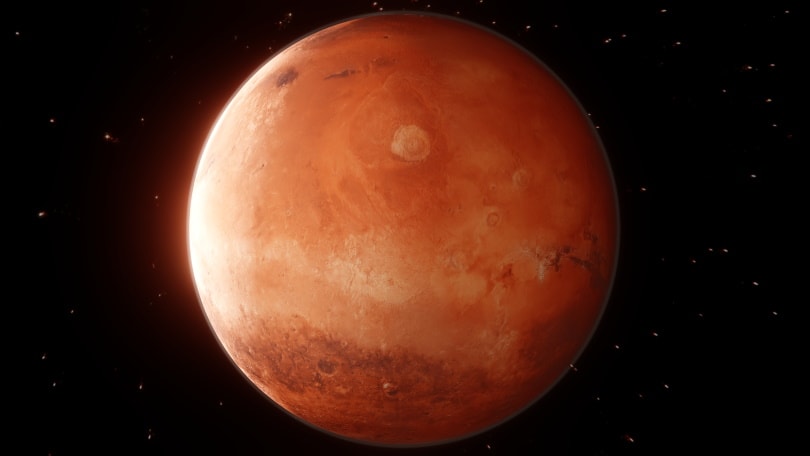
- Johannes Kepler, a German astronomer, mathematician, astrologer, and key figure in the scientific revolution, published Astronomia nova. This book contained the results of his ten-year-long investigation of Mars and his first two laws of planetary motion. According to Kepler’s first law, Mars has an elliptical orbit, which was a revolutionary idea at the time since all orbits were thought to be perfectly circular.
- Galileo Galilei used a primitive version of the refracting telescope to observe Mars, becoming the first person to use a telescope for astronomy. He later published his initial observations in a brief treatise called Sidereus Nuncius, or “Starry Messenger,” in 1610.
- Christian Huygens, a Dutch mathematician, physicist, astronomer, inventor, and a significant figure in the scientific revolution, drew Mars based on his observations. Using a telescope of his own making, he recorded a large dark spot on Mars, which was likely Syrtis Major.
- Christian Huygens observed the dark spot slowly disappear and gradually return to the same position at the same time the next day. He calculated that Mars has a 24-hour rotational period based on this observation.
- Giovanni Cassini, an Italian astronomer, mathematician, and engineer, improves on Huygens’ analysis and concludes that Mars’ rotational period is 24 hours and 40 minutes.
- Christian Huygens observes a white spot on Mars’ south pole, likely its southern polar cap.
- Christian Huygens published Cosmotheros, a philosophical treatise discussing what is required for a planet to support life. It also included speculations of extraterrestrial life and the formation of the universe deduced from his observations of Mars and other celestial bodies.
Formation of Mars
Mars was formed about 4.6 billion years ago during the birth of our solar system. However, the exact conditions under which Mars formed is a subject of debate, with two major theories attempting to explain the planet’s origins.

The Core Accretion Model
The leading and most widely accepted theory is the “core accretion model,” which suggests that the solar system’s origins lie in a solar nebula. Solar nebulas are large clouds of gas and dust from which stars and planets form by condensation. It is theorized that the nebula flattened into a rapidly spinning disk after collapsing underneath its own gravity, pulling matter into its center to give birth to our Sun. The remaining matter collided into minute planets known as planetesimals, asteroids, comets, and moons.
The newly formed Sun then released streams of charged particles in a plasma made up of electrons, protons, and alpha particles. This effectively created solar wind, which swept away lighter elements such as hydrogen and helium, leaving rocky, terrestrial worlds like Mars behind. This theory makes sense, as terrestrial planets dominate the inner regions of the solar system while the outer reaches are home to gas giants composed of light elements where the solar wind would have reasonably stagnated.
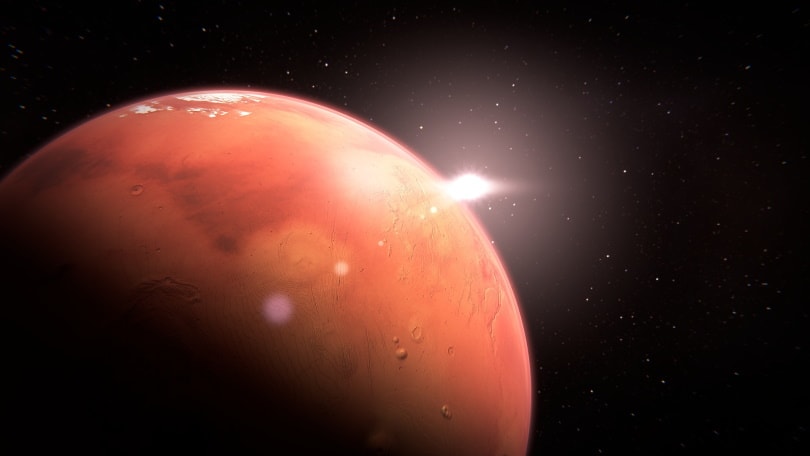
The Disk Instability Model
One major problem with the core accretion model is the idea that young planets would not have had sufficient mass to overcome the Sun’s gravitational pull. This would have likely led to the planets spiraling into and getting ripped apart by the Sun with haste. The disk instability model suggests that clumps of gas and dust were already bound together early during the formation of our solar system. Like the core accretion model, these clumps would slowly condense into planets, albeit much faster. This would have allowed the planets to reach a large enough mass necessary to overcome the Sun’s gravitational pull and maintain a stable orbit.
Mars’ Structure and Physical Characteristics
Much like the Earth, Mars is composed of a dense metallic core surrounded by a shell of increasingly lighter materials. The core consists primarily of iron, nickel, and sulfur and is surrounded by a silicate mantle. It is thought that this mantle is the source of much of Mars’ volcanic and tectonic activity, although it is currently dormant. Mars’ crust is abundant in silicon, oxygen, magnesium, aluminum, calcium, potassium, and iron, which is the source of the Red Planet’s namesake. The iron present in Mars’ regolith oxidizes to create rust, which is the burnt reddish-orange color we associate with the planet.
Mars is also home to Olympus Mons, the highest mountain in the solar system that towers at an impressive height of 13.6 miles. To put this massive shield volcano’s size into perspective, it stands about two and a half times taller than Mount Everest and would almost entirely cover the country of Poland. Contrasting Olympus Mons, Mars is also home to the deepest and longest system of valleys in the solar system. The Valles Marineris system runs for about 2500 miles with depths of up to 6 miles, comparable to the Mariana Trench, the deepest point on Earth. Individual canyons in the Valles Marineris system can be up to60 miles wide, with the forks where canyons meet spanning up to 370 miles.
Other parts of Mars host impressive, low-lying plains that are among the smoothest places in the solar system. Additional geologic features include channels, gullies, polar ice caps, and numerous craters up to 1,400 miles wide, such as Hellas Planitia.
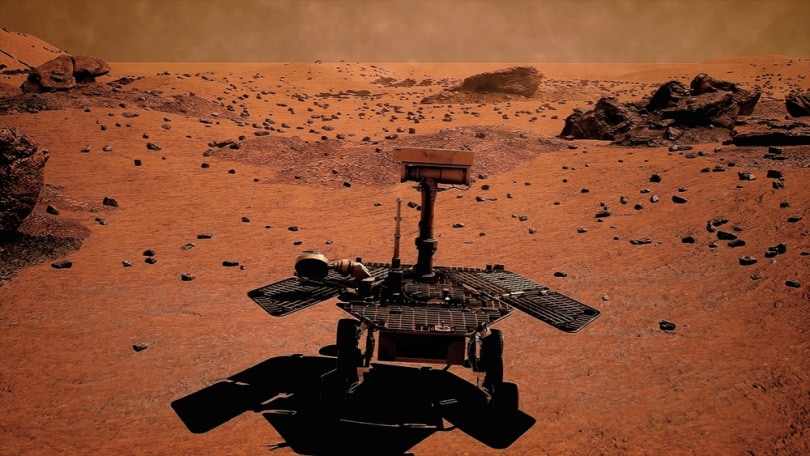
Mars’ Atmosphere & Magnetosphere
Mars is far colder than Earth, with temperatures averaging about -80°F and forecasts ranging from -195°F at the poles to 70°F at the equator. Its atmosphere is thin but still intact enough to support weather and clouds. It is thought that ancient Mars’ atmosphere used to be thick enough to support running water on its surface. However, solar winds have blown most of the lighter atmospheric molecules away. Mars’ atmosphere is about 100 times less dense than Earth’s, consisting of about 96% carbon dioxide, 1.93% argon, and 1.89% nitrogen with traces of water and oxygen. The atmosphere is also full of dust particles kicked up by ferocious wind storms, giving the Martian sky a light tan or pink color.
Although Mars used to have a magnetosphere, scientists precict it was lost it around 4 billion years ago due to numerous and relentless asteroid strikes. These impacts are hypothesized to have directly exposed the Martian ionosphere to the solar wind, which gradually stripped away the atoms on the outermost layers. Over time, this lowered Mars’ atmospheric density, likely leading to the destruction of its magnetic field.
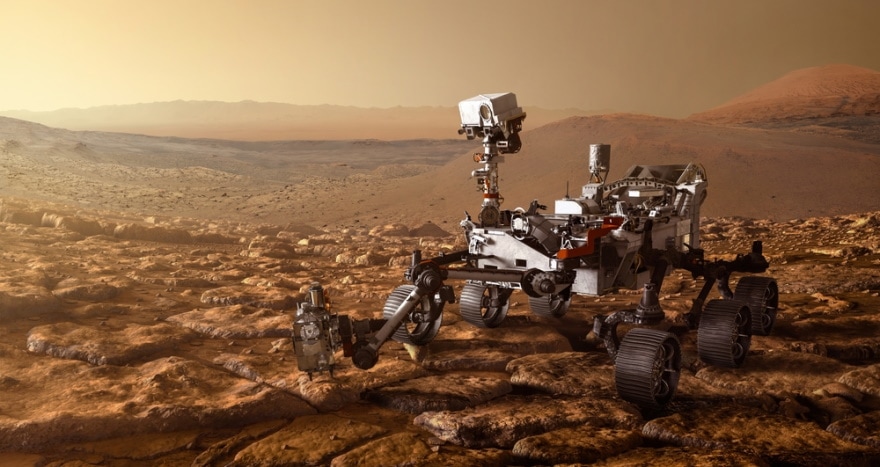
Moons of Mars
Mars is the host of two small moons named after the horses that pulled the chariot of Ares, the Greek god of war. These irregularly shaped moons were likely asteroids in the past due to their small size and composition, reminiscent of many objects in the outer asteroid belt. Unlike most spherical moons, Mars’ moons do not have enough mass to maintain hydrostatic equilibrium, which is the property that causes celestial bodies to assume spherical shapes.
The larger moon, Phobos, is littered with craters and characteristic deep grooves. At its widest, Phobos is about 17 miles across, which is relatively tiny. In a few million years, Phobos is expected to collide with Mars, which will rip it apart and likely turn it into a planetary ring. This is because Phobos orbits closer to Mars than any moon in the solar system, with an altitude of about 3,700 miles above the Martian surface. The smaller moon, Deimos, is about half the size of its companion at just about 9 miles across. It is also much smoother in appearance due to the extensive content of fine, loose dirt on its surface, which backfills most of its depressions.
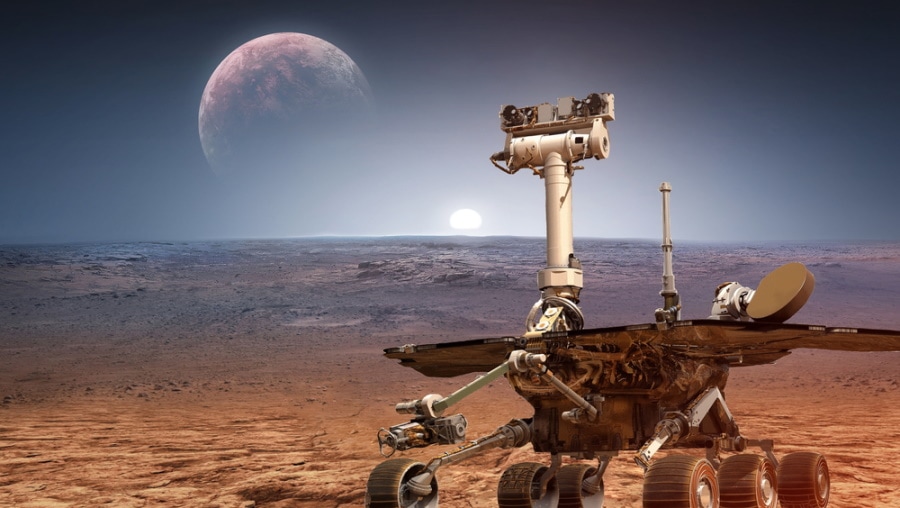
Significant Missions to Mars
Viking 1 & 2
Viking 1 & 2 were a pair of identical spacecraft launched in 1975. Each spacecraft consisted of an orbiter/lander pair, becoming the first U.S. mission to land on the surface of Mars and return photos of the surface. The two landers conducted several biological experiments to look for signs of life.
Spirit and Opportunity Rovers
Spirit and Opportunity were a pair of robotic spacecraft that landed on opposite sides of Mars in January 2004. They explored the Martian surface and made atmospheric observations, with both spacecraft finding evidence of ancient and possibly habitable Martian wetlands.
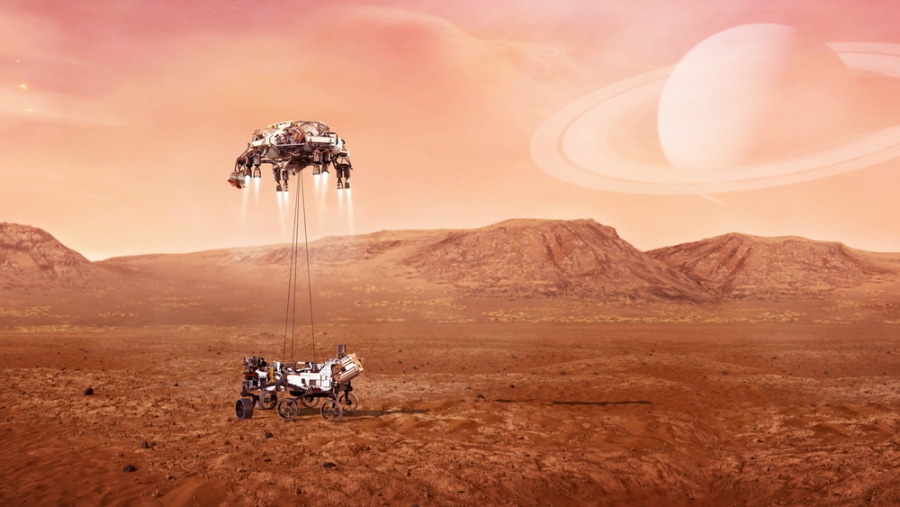
Phoenix Lander
The Phoenix Lander arrived at the Red Planet on May 25th, 2008. It was designed to study the water in the Martian arctic, look for evidence of a habitable zone, and investigate the ice-soil boundary for signs of biological activity. It functioned nominally for about five months, a full two months past its predicted lifetime.
MAVEN (Mars Atmosphere and Volatile Evolution)
The MAVEN orbiter is an operating spacecraft that was successfully inserted into Martian orbit on September 21st, 2014. MAVEN is helping scientists understand Mars’ upper atmosphere and climate history, including the mystery of its magnetic field and the history of its ability to sustain life.
Mars InSight
Mars InSight (Interior Exploration using Seismic Investigations, Geodesy, and Heat Transport) is a robotic lander that was launched on May 5th, 2018. It is designed to measure the seismic activity of “marsquakes,” provide 3D models of the planet’s interior, and measure internal heat transfer to understand Mars’ geological evolution better.
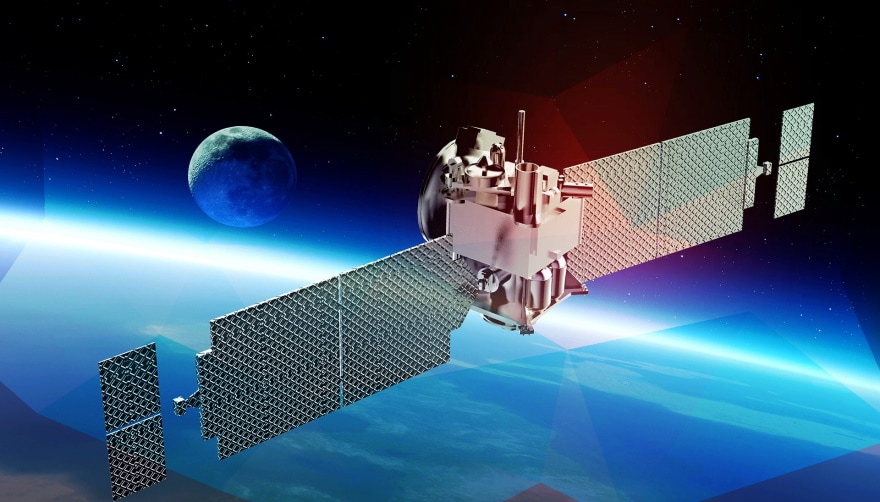
Perseverance Rover and Ingenuity
The Perseverance Rover was launched by NASA on July 30th, 2020 and landed in Mars’ Jezero Crater on February 18th, 2021. Perseverance also brought along a hitchhiker in the form of Ingenuity. Ingenuity is a Mars Helicopter that is helping researchers understand how rovers and aerial spacecraft can work together. Perseverance’s job, however, is to look for clues of ancient life and collect samples of rocks and regolith, which may potentially be returned to Earth.

Summary
Mars is a fascinating planet with a rich and exciting history. Although it is humanity’s most explored planet, there is so much we don’t know about it. We have sent dozens of spacecraft to the planet, allowing us to learn more about its ancient history and potential for sustaining life. Mars is also the top candidate for making humanity a multi-planetary species, with many adventurous missions planned in the future. Perhaps, we will get to leave our footprint on the Red Planet one day.
Featured Image Credit: joshimerbin, Shutterstock
About the Author Robert Sparks
Robert’s obsession with all things optical started early in life, when his optician father would bring home prototypes for Robert to play with. Nowadays, Robert is dedicated to helping others find the right optics for their needs. His hobbies include astronomy, astrophysics, and model building. Originally from Newark, NJ, he resides in Santa Fe, New Mexico, where the nighttime skies are filled with glittering stars.
Related Articles:
When Were Binoculars Invented? History, Today & Future
15 Crucial Facts About Ultraviolet Rays & the Sun
What Constellation Is Spica In? The Interesting Answer!
10 Interesting Leo Constellation Facts, Myths, and FAQs
15 Interesting Pegasus Constellation Facts, Myths, and FAQs
6 Interesting Sagittarius Constellation Facts, Myths, and FAQs in 2024!
What Are Constellations? Where Did They Come From?
8 Interesting Libra Constellation Facts, Myths, and FAQs
